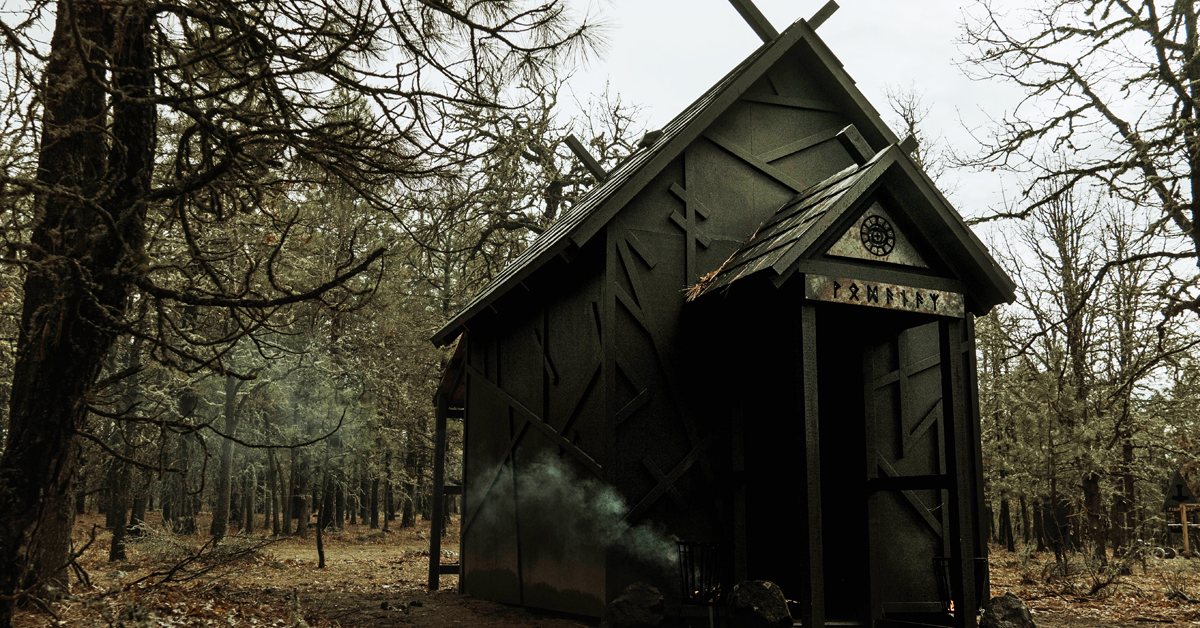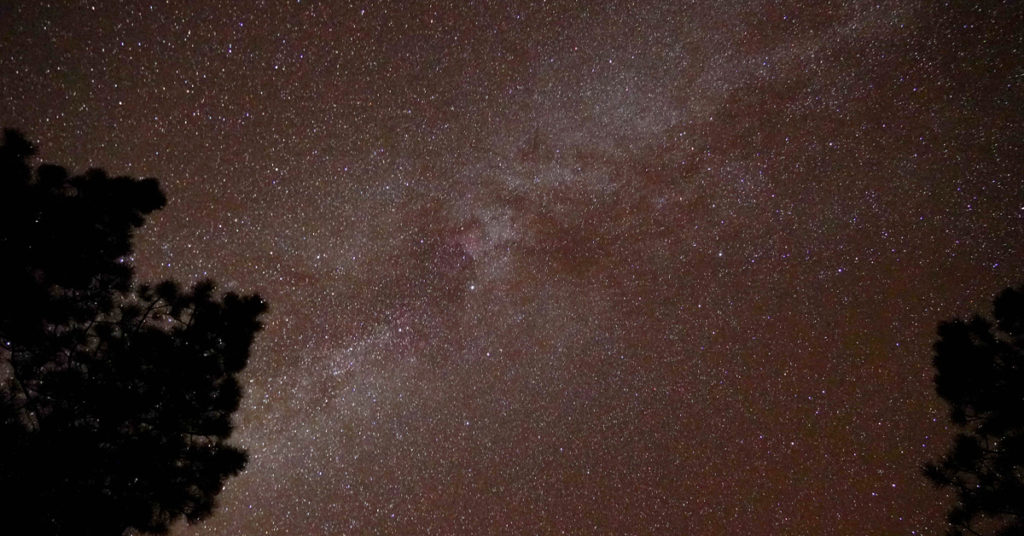With some help from friends, this summer I designed and built this structure dedicated to Wōdanaz, the Proto-Germanic name of the god Odin or Óðinn who appears in the Old Norse Eddas and Sagas.
The name Óðinn is derived from the word Óðr, which has a variety of meanings having to do with the mind or soul, but also madness and possession, as well as inspiration and poetry.
Óðr is a descendant of the Proto-Germanic word wōdaz, meaning “excited, energized, spirited, frenzied, obsessed” as well as “angry” or “furious.” Proto-Germanic is largely theoretical and unattested, as few written records of it exist, but runic inscriptions of the word Wodan have been found on various continental objects.
Stepped back even further into reconstructed languages, the word becomes *weh₂t- in Proto-Indo-European. *Weh₂t- is likewise thought to have meant “excited, inspired, possessed” or “raging.” Proto-Indo-European is believed to be a root language spoken in the Pontic-Caspian steppe of Eastern Europe about 5,000 years ago. The language branched out to the East and West, and its descendants include most of the languages spoken in the West today, as well as Iranian languages, Sanskrit, Hindustani, and many more. Notably, a descendent of the word *weh₂t- is the Latin vātēs, which indicates a seer, oracle, prophet or poet.
Broadly speaking, from both the etymology of his theonyms and the surviving lore concerning Odin, he represents an aspect of masculine divinity that deals with “inspired” activity.
Creativity is always a little bit crazy. We can choose to consciously develop ideas after we have them, but inspiration itself “comes to us” from the subconscious. It bubbles up from darkness. Wōdaz is that magic moment of inspiration where we lose ourselves and slip out of time and something “overcomes” us. It is a state of transcendence.
In more practical and everyday terms, I believe there is an overlap between the concepts of wōdaz and what Mihály Csíkszentmihályi called a “flow state.” A flow state is a peak experience when we are so focused on performing a challenging (but not overwhelming) task that we lose track of time and there is a “merging of action and awareness.”
I have experienced what I would consider flow states while writing, working on computer-related tasks, designing, painting, lifting, exercising and sparring. For more information on flow states, I would recommend the book by Mihály Csíkszentmihályi [pronounced: Me high, Cheeks send me high].
The best and most comprehensive overview I have ever read on Wōdanaz is a book of the same name written by Stephen Flowers, if you can get your hands on a copy. I ordered mine directly through his Facebook page.
I have come to see Wōdanaz or Odin, the “Allfather,” as a late and particularly Germanic manifestation of an older conception of paternal divinity — the original “sky father” — who academics have conceptualized as Dyēus Ph₂ter.
The late Germanic idea of Odin is often portrayed rather darkly, as a malevolent trickster, and Odin has become attractive as a somewhat Luciferian figure to young black metal enthusiasts who want to rebel against Christianity and Christian morality. In many cases this “darkness” itself is probably in part an effect of the Christian demonization of pre-Christian European paganism. Odin was often portrayed in a devilish or “satanic” role in European folklore, and in the late 20th Century many youthful Satanists matured into Odinists as they moved away from reaction in search of a more positive paradigm. For as long as I can remember, there has been a direct pathway from Satanism to heathenry, Asatru and Odinism. As they say, “it’s a thing.”
However, in all of this dark imagery, some of the more Olympian aspects of the lore concerning Odin seem to get lost. This god who is always tricking giants and appearing to men in a foreboding way was also shown on a high seat overlooking the world, and overseeing a great golden hall of heroes. As in the myth concerning his acquisition of the mead of poetry from the giants — which has become one of my favorite stories about him — he is both a serpent and an eagle. He delves into darkness with a noble purpose, and emerges as a noble creature, carrying the golden mead of inspiration to share with gods and men. This transformation into an eagle is an echo of something we also see in Zeus.
Based on his comparison of the surviving myths from various Indo-European cultures, Georges Dumézil theorized that the sovereign function of society and divinity was separated into a formal, judicial aspect and a wild, unpredictable “supernatural” aspect. In modern men’s psychology, these aspects are assigned to “king” and “magician” archetypes. These two types are not dissimilar in character to the productive exchange between the Apollonian and Dionysian as described by Nietzsche in The Birth of Tragedy and mentioned in my last book, A More Complete Beast. In the work of Dumézil, these two functions of divine, paternal leadership were normally separated into two opposing but complementary gods. What is particularly interesting about Odin is that he is both Apollonian and Dionysian. However, it is that wild, unpredictable and mysterious side of Odin that is highlighted in modern culture, but also in the surviving lore and even his name itself.
What Odin illustrates for me is the principle that it is the work of the paternal figure — the work of man — to venture into darkness and chaos to bring forth wisdom, inspiration and beauty. He slips between worlds — on his eight-legged horse, whose name, Sleipnir, means “the slipper” — and brings something back. The defining story of Odin is his sacrifice of himself to discover the mystery of the runes. He hangs in darkness for 9 nights, until he takes up the runes and falls down screaming. For those who aren’t familiar, the runes are not only writing, but each symbol is also associated with some concept or larger meaning. One can employ the runes to explore these primal concepts and meditate on them, if one is so inclined.
This structure is named the Wōdanastallaz — the stall of Wōdanaz. Neopagans sometimes call altars “stalls.” We stepped the name back into Proto-Germanic, which is part of the culture of Waldgang, my Germanic pagan sacred space in the Pacific Northwest.
I envisioned the Wōdanastallaz as a place to encounter and explore darkness and mystery, following the Odinic example. Several small rituals have already taken place inside the building at various stages of completion. During group events, ritual ash is prepared in this building, and participants are invited inside to be ceremonially anointed.
Inspired by German Expressionism, the black structure of its external face is covered with a chaotic intersection of runes from both the Younger Futhark and the Elder Futhark. The floor is dirt, so that there is no barrier blocking a connection to the earth. There are no windows, and at night it can be made completely dark inside. The foundation was ritually blooded, and red runic inscriptions were made all over the structure before it was painted black.
The focus point in the stallaz is a steel sun wheel with an eye in the center that I use to symbolize “solar vision” and the visionary eye of Odin, the Allfather. Another “solar vision” symbol can be found on the entrance awning, above the word Wōdanaz, spelled in runes. Various art objects, remains of sacrifices, and gifts of tribute can be found throughout the internal space. More will be added as time goes on and the space continues to evolve.



